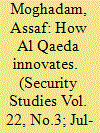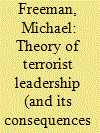| Srl | Item |
| 1 |
ID:
123395


|
|
|
|
|
| Publication |
2013.
|
| Summary/Abstract |
Innovative terrorist organizations pose exceptionally dangerous threats because of their potential to surprise declared enemies, inflict heavy costs upon them, and set new trends that other militant groups seek to emulate. Despite this importance, researchers have shed little light on where terrorist innovation originates. Although military innovation scholars have emphasized the importance of both top-down and bottom-up innovation, the few existing studies on terrorist innovation have acknowledged the importance of the terrorist leadership but largely ignored the role played by middle- or lower-ranking operatives in the innovation process. This study examines the planning of the September 11, 2001 attacks and finds that, contrary to the predominant claims on terrorist innovation, the 9/11 attacks featured both top-down and bottom-up processes of innovation, with the latter including a critical role played by an independent terrorist entrepreneur. Theoretically, the findings suggest that the conventional wisdom of the predominance of top-down innovation in terrorism is dependent on a problematic assumption, namely that terrorist groups are centralized, hierarchical, and localized entities. As more terrorist groups adopt decentralized structures, they are increasingly likely to display multi-directional processes of innovation. The study has important implications for counterterrorism policy. It suggests that thwarting the most innovative terrorist groups requires targeting senior- and middle-management operatives of the group itself and expending greater effort at apprehending independent terrorist innovators with fluid organizational affiliations. A mix of offensive and defensive counterterrorism strategies, coupled with greater international cooperation, is critical to achieving this goal.
|
|
|
|
|
|
|
|
|
|
|
|
|
|
|
|
| 2 |
ID:
133543


|
|
|
|
|
| Publication |
2014.
|
| Summary/Abstract |
States often target terrorist leaders with the belief that the leader's death or capture will cause the terrorist organization to collapse. Yet the history of this strategy of "leadership targeting" provides a mixed record-for every example of effectiveness, there are similar examples of ineffectiveness. The central question of this article is: what makes a terrorist leader important? Specifically, what does a terrorist leader do that no one else can do (or do as well) for the organization? To answer this question, I develop a theory of terrorist leadership that argues that leaders might potentially perform two main functions: they can provide inspiration and/or operational direction (or not for both). I also theorize as to how and why the provision of these functions changes over time as the organization itself changes. The consequences for leadership targeting flow naturally from this theory-when leaders provide these functions to the organization, leadership targeting is most likely to be effective. Case studies of Algeria, Peru, and Japan offer insights into why some cases of leadership targeting were effective and why others were not. The conclusion extends this model with an analysis of al-Qaeda's prospects after the death of bin Laden.
|
|
|
|
|
|
|
|
|
|
|
|
|
|
|
|